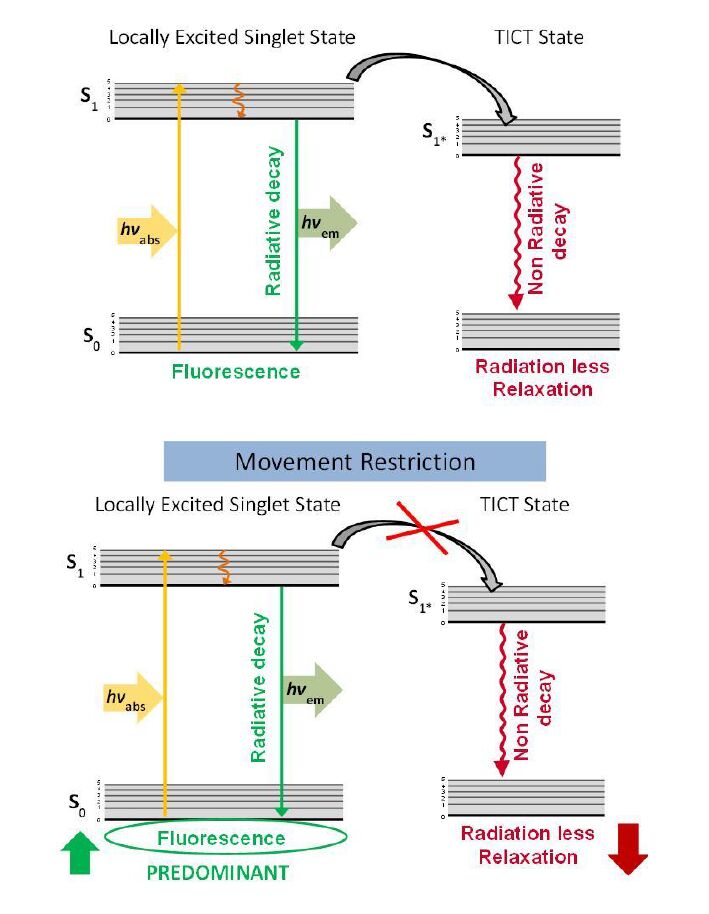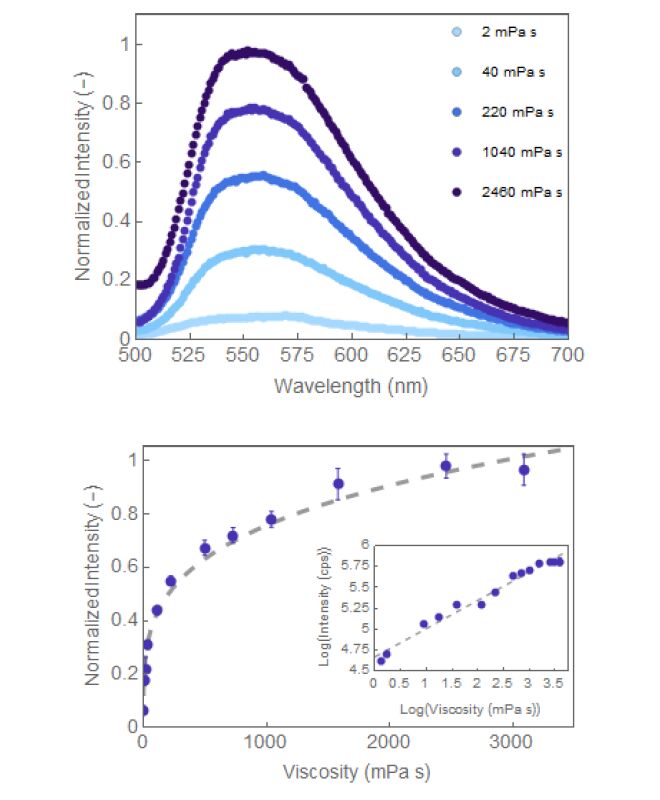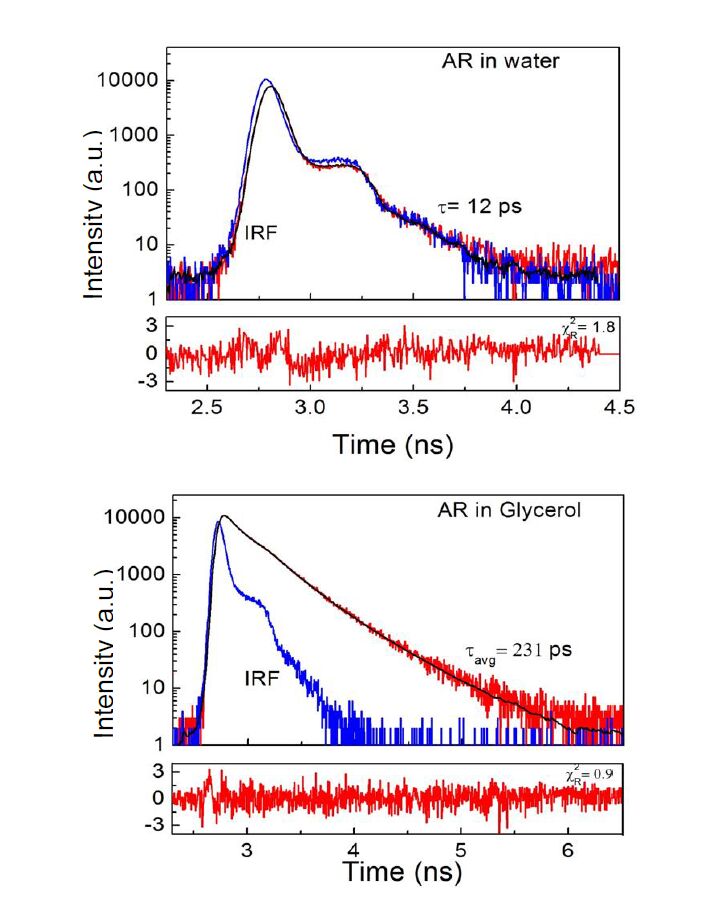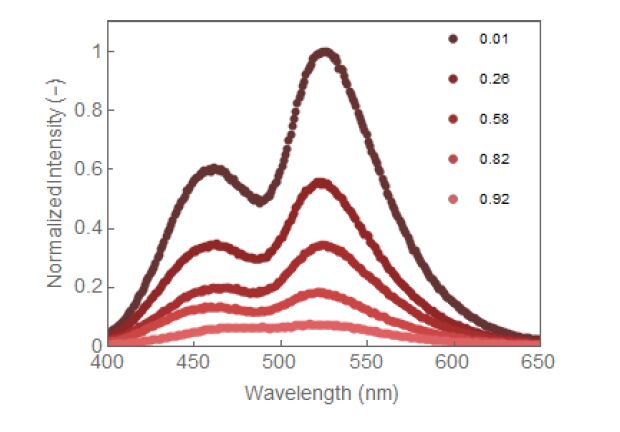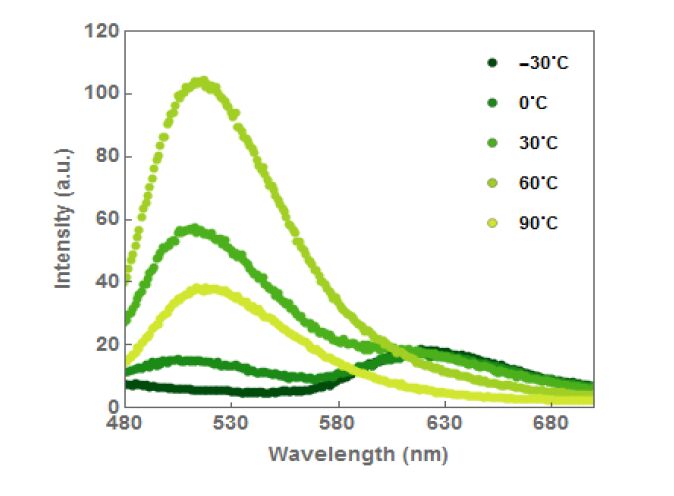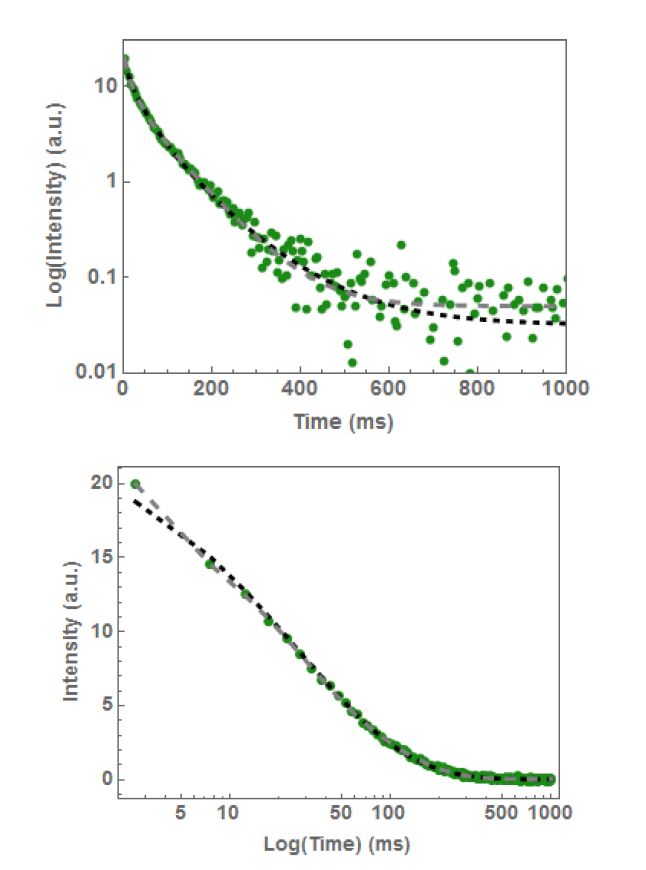1. Introduction
A vast number of compounds either naturally present in or intentionally added to foods—natural colors, synthetic dyes, antioxidants, flavors, vitamins…—are photoluminescent: they reemit absorbed light as either prompt fluorescence or delayed phosphorescence [1]. This review will focus on the potential use of edible, that is, potentially GRAS (generally-recognized-as-safe), photoluminescent compounds as intrinsic sensors of food quality, stability, and safety. An extensive summary of the photophysical properties of fluorescent natural organic compounds, including those present in foods, was published by Wolfbeis in 1985 [2]. More recently, Christensen et al. [3] make available a web-based food fluorescence library (www.models.kvl.dk) providing steady state fluorescence data on intact foods and solutions of the most common intrinsic edible fluorophores, molecules such as tryptophan, NADH, and chlorophyll. In recent years, the need to authenticate the origin and/or composition of select foods has driven interest in fluorescent fingerprinting [4,5,6,7,8]. Despite such efforts, knowledge of the basic photophysical properties and environmental sensitivities of edible lumiphors—fluorophors and phosphors—is dispersed and little appreciated, despite the known essential value of such information for sensor development.
More specifically, there has been little effort to investigate how the intensity/quantum yield, lifetime, excitation/emission energy distribution, or polarization of edible luminescent chromophores can provide direct molecular level information on the physical—viscosity, mobility/rigidity—and chemical—polarity, pH—properties that are known to be related to and indicative of food quality, stability and even safety. Most such photophysical information is either unknown or distributed piecemeal, and thus buried, throughout the scientific literature.
Emission from each lumiphor exhibits unique photophysical properties determined by its specific structure—aromatic ring, hetero-atoms or functional groups such as alcohol and amine—the nature of the electronic excitation—change in bond order, spin multiplicity, transition dipole moment orientation—and the characteristics of the local environment surrounding the probe [1,9]. Information on how the photophysical properties of edible fluorophores respond to, and thus potentially report on, specific chemical and physical properties of the food matrix can be used to monitor food quality, stability and safety in real time and on the fly. The use of noninvasive edible luminescent probes for measurements in in-line during manufacturing or in-situ during distribution and use can be of particular importance within the food, medical, and pharmaceutical arena.
2. Challenges in The Utilization of Edible Fluorophores as Molecular Sensors in Foods
The use of edible probes as molecular sensors in foods presents several challenges:
a) Probe sensitivity. In comparison to standard luminescent probes, such as fluorescein or rhodamine, many native or added edible molecules often present low quantum yields (Φ) and short lifetimes (τ) under conditions of interest in food testing, i.e., liquid solution at room temperature: the Φf of retinol at room temperature is 0.03-0.006 [2,10], for example, and τ for the singlet excited state (S1) of β-carotene is about 10 ps [11]. Therefore, although these edible chromophores have been studied in the past, their potential as luminescent sensors has been ignored or considered limited. The availability of equipment with higher sensitivity, which facilitates obtaining adequate signals from less efficient chromophores, and the enormous appeal of using nontoxic, already present molecules as sensors justify the current study of these potential molecular probes.
b) Characteristicsof the medium. Luminescence spectroscopy is typically applied to optically clear, diluted samples [12]. Most foods do not fit this description: they are turbid, multiphase, and concentrated, which normally results in extensive scattering and significant contributions of background to the overall emission. Although front-face mode [13,14] can be used to acquire appropriate measurements in absorbing or scattering condensed phases, such as most foods, it should be noted that such measurements reflect the characteristics of the sample surface and in heterogeneous solid foods these measurements are not necessarily representative of the entire sample; additional testing of the sample interior using fiber optics is necessary to increase accuracy. Differentiating the probe’s signal from extraneous luminescence can be accomplished either by subtracting the background signal, provided that no interactions between the background and the probe are present, using appropriate filters, or employing post-processing data treatments, such as parallel factor analysis (PARAFAC) [15]. Additionally, the appropriate selection of an edible probe with large Stokes shift (the difference between the excitation and emission wavelength) and emission in the far red also facilitate differentiation from background [16].
c) Probeconcentration. High concentrations of chromophore result in inner filter effects that attenuate the excitation beam and/or re-absorb the emitted (typically) fluorescence. Conversely, low concentrations of chromophore might be problematic under certain conditions. While attaining appropriate concentrations in model systems is trivial, modifying the probe concentration in intact food samples is often not, often being accompanied by loss of sample integrity or significant changes in sample characteristics. To circumvent problems associated with probe concentration several strategies, such as sample dilution or concentration (if appropriate), adequate selection of testing conditions (slits, excitation wavelengths, front-face geometry) and mathematical corrections [1], can be followed.
d) Complexsignals due to mixtures of fluorophores. The large number of chromophores present in foods results in competing signals and can limit the development of practical commercial applications. Signal overlapping is often observed in complex biological samples, including foods [17]. Besides probe selection, chemometric techniques based on multivariate data analysis and/or decomposition algorithms [18,19,20] can be used to decouple signals from a mixture of luminescent molecules.
e) Local versus bulk properties. It should be noted that luminescent probes are site specific and operate as molecular sensors, that is, they report on environmental properties at the local molecular level around the probe. Because of that, they present a unique opportunity to assess and investigate microstructural characteristics and local quality attributes—pH, polarity, water activity—of actual undisturbed foods and to provide maps of how these properties differ throughout the food. Their use as sensors of bulk food properties thus has some limitations since local properties might not be well correlated with the macroscopic properties of the food. Supportive data and judicious interpretation of the photophysical properties of the probes is required before using a local probe as a sensor of a bulk property.
f) Limitedknowledge on environmental sensitivity. The structure of an edible chromophore establishes opportunities for its interaction with the local environment. The intensity, lifetime, energy and polarization of emission are largely dependent upon the strength of the probe’s interactions with the surrounding media and the time scale of matrix or fluorophore relaxations that modulate these interactions. Thus, fluorophores containing hydroxyl and other polar groups may be sensitive to solvent polarity and hydrogen bonding potential, those containing amine and carboxylic acid groups are often sensitive to pH, and those chromophores that relax the singlet state through internal rotations about bonds may be sensitive to solvent microviscosity and molecular crowding. Although the photophysical properties of several edible chromophores have been characterized, extensive analyses on how their signals are affected by the chemical or physical attributes of the environment have been seldom reported or conducted [21,22]. Operationalizing edible luminescent probes as molecular sensors in foods requires a systematic characterization of those environmental sensitivities that can provide information about specific attributes of food quality, stability, and safety. There is thus a distinct need for a library summarizing the photophysical properties of edible luminescent molecules and until such a library exists, their general applicability as sensors of food quality may be limited.
In the following sections we will summarize current advances, limitations and tested applications of edible luminescent probes in model food systems.
3. Luminescent Edible Probes of Food Quality and Safety: Characterization and Uses
Some examples of edible optical probes with specific photophysical properties that be used to report on progressive degradation and stability of quality attributes in foods are illustrated in Figure 1.
3.1. Edible molecular rotors as sensors of a food’s micro (and bulk) physical properties
The physical properties of foods, e.g., viscosity, play an important role in food acceptance and quality. Identifying molecular probes and developing protocols to continuously and non-invasively report on physical properties can reduce food waste and improve food quality without increasing production costs.
Synthetic dyes, due to their stability and functionality at low concentrations, are widely used in food products to enhance appearance. Allura Red AC (FD&C Red No. 40), Tartrazine (FD&C Yellow No. 5), Sunset Yellow FCF (FD&C Yellow No. 6), Fast Green FCF (FD&C Green No. 3), and Brilliant Blue FCF (FD&C Blue No. 1) are currently approved for their use in food and pharmaceutical products in the United States [23]. The potential application of these synthetic monoazo—Allura Red AC, Tartrazine, Sunset Yellow FCF—and triarylmethane—Fast Green FCF and Brilliant Blue FCF—food dyes as fluorescence probes to characterize micro and bulk viscosity of liquid and semi-solid foods has recently been described [16,21,24]. These dyes typically exhibit weak, often undetectable, fluorescence in low viscosity fluids such as water; however, their fluorescence quantum yield, and thus emission intensity and lifetime, increases significantly with an increase in the viscosity of the surrounding medium. Thesesynthetic dyes thus exhibit presumptive molecular rotor behavior; i.e., they include groups that can rotate in the excited state and quench fluorescence. The environmental sensitivity of molecular rotors towards the physical state of the surrounding media is based on the potential formation of two alternative states upon photoexcitation, namely a locally excited (LE) planar state or a twisted intramolecular charge transfer (TICT) state. Deactivation from the TICT state is predominantly through a non-radiative pathway (and thus does not result in emission). Conversely, deactivation from the LE state occurs with emission of a photon. Since formation of the TICT state requires intramolecular motion of (in the case of food dyes) large aromatic groups, it is slower in more restricted environments. These two competing decay pathways determine the sensitivity of these probes to the physical state of the surrounding environment [25]. Energy state Jablonski diagrams summarizing this behavior are presented in Figure 2. It should be noted that preliminary research on natural colors, such as betalains and chlorophyll, and their derivatives have also indicated that internal twisting constitutes a predominant deactivation pathway for natural dyes in fluid environments [26,27]; therefore, some natural dyes are also potential molecular sensors of the physical state of foods. Examples of synthetic and natural food dyes exhibiting presumptive molecular rotor behavior with excitation and emission wavelengths are provided in Table 1.
Table 1.Luminescent food probes with presumptive molecular rotor behavior
| Type
|
Compounds
|
λEx (nm)
|
λEm (nm)
|
References
|
| Azo Dyes
|
Allura Red, Sunset Yellow, Tartrazine,
Citrus Red
|
450-540
|
540-610
|
[21]
|
| Tri-arylmethane Dyes
|
Fast Green
Brilliant Blue
|
580-600
|
650-700
|
[1]
|
| Natural colors
|
Betaxanthins
Conjugated chlorophylls*
|
470
440
|
500
685
|
[27,29,80,81]
|
| *Derived from chlorophylls. |
Given that the environmental sensitivity of molecular rotors reflects the hindrance of intramolecular rotation [28], any increase in local viscosity or molecular crowding will increase the fluorescence emission intensity [29]. Therefore, they not only can report on the physical state of solutions (viscosity) and materials (rigidity) but can also report on specific processes of industrial importance such as cross-linking, aggregation [30,31,32], polymerization [33] or phase changes [34] in foods.
The sensitivity of food dyes to the microviscosity of the surrounding medium has been tested in numerous models systems, such as glycerol-water, and aqueous monosaccharide and disaccharide solutions [21]. In these model systems, the viscosity dependence of the fluorescence quantum yield, lifetime or emission intensity followed a power law relationship. The Förster-Hoffmann equation [35]:
|
$log{\rm{}}{{\rm{\Phi }}_F} = {\rm{}}C + x{\rm{}}log{\rm{}}\eta $
|
(1)
|
is normally used to describe the power law relationship between quantum yield (Φ) and viscosity ($\eta$). Since quantum yield and fluorescence emission intensity are proportional, the relationship between fluorescence intensity and viscosity is normally reworked from Eq. 1 and expressed in the following manner [28]:
|
${{I}_{F}}=\alpha {{\eta }^{x}}$
|
(2)
|
where α is considered a measure of the probe’s brightness and x a measure of its sensitivity to local viscosity. The highest theoretical value for x is 0.66 [36] and values in the range from 0.25 to 0.6 (e.g., 0.26-0.4 for modified nucleosides [37], 0.53 for 9-(2, 2-dicyanovinyl)-julolidine (DCVJ), and 0.52 for 9-(2-carboxy-2-cyano) vinyl julolidine (CCVJ) [38]) have been reported in glycerol-based solutions. In the case of synthetic food dyes, the viscosity sensitivity is between 0.32-0.48 in similar systems [21]. The fluorescence of Sunset Yellow FCF (FD&C Yellow 6) also varies with viscosity in glycerol/water mixtures by a power law model (Eq. 2) as the log/log plot of fluorescence intensity versus viscosity is linear (Figure 3 - bottom and inset.)
Current research on the photophysical properties of synthetic food dyes thus demonstrates their potential as molecular sensors of the physical properties of foods. However, their effective implementation and extensive application presents some challenges. First, the fluorescence lifetime of these synthetic food dyes is extremely short in fluid environments; for example, the lifetime of Allura Red FCF in water at room temperature is 12 ps and other dye lifetimes are comparable. This might limit the use of edible molecular rotors in Fluorescence Lifetime Imaging Microscopy (FLIM) in comparison with current non-edible fluorescent probes that report on changes in local viscosity [39,40,41]. This short lifetime in fluid solutions has motivated the use of Allura Red FCF, and potentially of other synthetic food dyes, as an adequate alternative to commonly employed light scattering elements in time resolved measurements when microchannel plates (MCPs) are not available [42]. Allura Red’s fluorescence lifetime increases one order of magnitude when dissolved in glycerol (231 ps) (see Figure 4), which reaffirms the molecular rotor behavior of these dyes. Second, since these edible probes operate as molecular sensors, their sensitivity to bulk properties modulated by large macromolecules such as hydrocolloids is problematic. Hydrocolloids have the ability to increase bulk viscosity even at very low concentrations. Because of their different molecular weights, structural characteristics (linear vs. branched), and interactions with the solvent and possibly the probes
(electrostatic vs. hydrogen bonding, for example), hydrocolloids influence molecular crowding and hydration around the probe in different ways. This, in turn, leads to differential sensitivity. The viscosity of dextran, hydroxyethyl starch [43], collagen [44] and methylcellulose [21] solutions could be monitored using either non-edible or edible molecular rotors. However, the bulk viscosity of carboxymethyl cellulose was significantly under estimated using edible molecular rotors.
To date, several effective applications of edible molecular rotors as sensors of local and bulk physical properties of model systems and of actual foods have been reported. Besides their utility in hydrocolloid solutions, their sensitivity to the bulk rheological properties of gelatin desserts and to changes in consistency of custards during cooking has been demonstrated [45]. Additionally, Du et al. [16] have identified the efficacy of a liposoluble edible azo dye, Citrus Red 2, as a sensor for the micro-viscosity of oils confined in colloidal fat crystal networks. The luminescent response of the azo dye could not be unequivocally related to solids content but rather to a decrease in the void volume, expressed in terms of the fractal dimension of the fat network in which the liquid oil was entrapped. This observation emphasizes that the fundamental basis for environmental sensitivity of molecular rotors involves hindrance of intramolecular rotation.
Despite theirsuccessful use in these applications, a deeper understanding of the molecular scale interactions of the molecular rotors and their environment is required to fully delimit their appropriate operating conditions.
3.2. Generally recognized as safe (GRAS) compounds as sensors of food chemical quality
Food chromophores are not only sensitive to physical properties but are also to chemical properties relevant to food quality. The fluorescence signals of quinine and anthocyanins exhibit characteristic changes with the pH of a solution [46,47,48,49,50,51] and can thus be potentially exploited to continuously monitor food spoilage and deterioration that results from microbial growth or chemical reactions. This application requires assessment of the degradation kinetics of the probes in model and actual foods. Curcumin and anthocyanins are also reported to be sensitive to the presence of amines and high pH and thus provide opportunities for monitoring degradation of meats and fish fillets. Table 2 presents examples of edible compounds that exhibit sensitivity to several chemical and physicochemical attributes.
Table 2.Luminescent probes with sensitivity to food quality attributes
| Food Quality Attribute
|
Compounds
|
λExc /nm
|
λEm /nm
|
References
|
| aw
|
Fisetin
Quercetin
|
345
370
|
400/520*
490
|
[82]
|
| pH
|
Quinine
|
400
|
525
620*
|
[48]
|
| Amine
|
Curcumin
Anthocyanin
|
400-550
|
550-700
|
[46,47,83,84,85]
|
| *Dual band emission. |
Among the compounds listed in Table 2, flavonols are currently being studied as promising fluorescent probes for water activity (aw) in foods. Monitoring aw during food production and storage is crucial since it is a determining factor for microbial growth and biochemical reactions that affect the quality of foods, including discoloration and nutrient degradation. Currently, methods of measuring aw, such as those using dew point hygrometers, require a period of vapor-liquid equilibration prior to measurement [52,53] and report on the overall aw of the product, providing no spatial resolution within a sample. Fluorescent probes have the potential to eliminate this equilibration period and provide measurements of the distribution of the property of interest, aw, in a product, allowing for more rapid, noninvasive, site specific, and in situ determination of aw.
Flavonols are plant-derived phenolic compounds that have antioxidant, anti-inflammatory, and photosensitizing functions [54,55]. They are naturally occurring, or commonly added to foods due to their antioxidant activity, and also exhibit fluorescent properties that are highly sensitive to the chemical properties of the local microenvironment, particularly hydrogen bonding and polarity [56,57]. It also appears that flavonols, particularly those that exhibit excited-state intramolecular proton-transfer (ESIPT), are capable of functioning as fluorescent probes of aw. Fisetin and 3-hydroxyflavone (3HF), are ESIPT fluorophores that display dual fluorescence bands corresponding to emission from a normal (N*) and a lower energy photo-induced tautomer (T*) form (see Figure 5).
In these compounds, the 3-OH--C=O intramolecular hydrogen bond is known to facilitate proton transfer. The normal (N*) and tautomer (T*) forms vary in charge distribution and therefore interact differently with their molecular environments, resulting in differential spectroscopic sensitivities of the two emission bands to the solvent environment [58]. The emission intensity of the normal (IN*) and the photo-induced tautomer (IT*) of both fisetin and 3HF are sensitive to the aw of solvent mixtures, decreasing exponentially as aw increased. Additional sensitivity to aw is observed in terms of the ratiometric intensity response IN*/IT* and the band shift difference in emission wavelength between N* and T*, λT* − λN*. The ratiometric response, IN*/IT*, of 3HF increases with an increase in H-bond donor concentration and high solvent polarity [58]. Fisetin IT* decreases with increasing solvent polarity and a dramatic red shift of the normal band is observed due to solvent dipolar relaxation around the excited N state [56]. The hydrogen-bonding ability of the solvent is known to affect IN*/IT* since strongly hydrogen-bonding solvents compete for hydrogen bonding at the 3-OH and O-11 sites and disruption of the intramolecular hydrogen bond increases the barrier height for tautomer formation in the excited state [59]. Thus, in increasingly hydrogen-bonding solvents, i.e., at higher aw, the rate of formation of the tautomer is expected to decrease, increasing IN*/IT*. This is the case with fisetin (Figure 6 - bottom) and 3HF (not shown), where IN*/IT* is sensitive to aw at values higher than a critical aw of 0.85 and 0.65, respectively. For both fisetin (Figure 6 - top) and 3HF, a blue shift in the tautomer band was observed at high aw, resulting in a smaller band shift. It thus appears that with increasing solvent polarity, the ground state of the tautomer is better stabilized by solvation than the excited state tautomer [60]: at high aw, T* is thus higher in energy and emits at a lower wavelength. Since the position of the N* band remains relatively constant, the result is a decrease in the band shift. The band shift is sensitive to aw at values above 0.8, and 0.6 for fisetin and 3HF, respectively. Based on this observations, fisetin can be considered a promising probe of aw in foods, as it is both GRAS and naturally occurring, while also providing a reproducible, concentration-independent signal and sensitivity to aw at ranges most critical to the microbial safety of foods, i.e., aw > 0.85.
3.3. Food grade chromophores in triplet state as probes of molecular mobility
Fluorescence and especially phosphorescence can provide indirect information about the molecularmobility of local environments [1,61]. Phosphorescence decay occurs on a slower time scale, e.g., 10−4 to 1 s, than fluorescence (typically ≤ 10−8 s). The longer lifetime of the triplet state makes phosphorescence more sensitive to, and thus more suitable for studying, the slow molecular motions in solid food matrices [61]; in addition, phosphorescence is exquisitely sensitve to contact quenching by molecular oxygen [9,64]. Phosphorescence from edible compounds that exhibit high quantum yields and relatively long triplet lifetimes thus provides a sensitive way to probe molecular mobility and oxygen permeability in amorphous solid foods, that is, solid foods lacking the 3D ordered structure characteristic of a crystal and that are hard, rigid and brittle at low temperature and soft, rubbery, and flexible at high temperature. Most low and intermediate water content foods, e.g., extruded snacks or freeze dried commodities, are partially or completely amorphous. Changes in molecular mobility of amorphous carbohydrates and proteins directly affect the physical, chemical, and microbiological stability of these products, consequently they are of great importance to the food industry.
The phosphorescence signals from the food dye erythrosin B (FD&C Red No. 3) [62,63,64,65], the amino acid tryptophan [44], the flavor vanillin [66,67], and other food grade chromophores can provide information about local structure and mobility of the amorphous solid matrix. Table 3 presents examples of food grade chromophores with known triplet states and their photophysical properties.
Table 3.Luminescent food probes with well-characterized triplet states
| Type
|
Compounds
|
λEx (nm)
|
λEm (nm)
|
References
|
| Aromatic Amino Acids
|
Tryptophan (W)
Tyrosine (Y)
|
260-300
250-285
|
~345
~440* (W)
~310
~380* (Y)
|
[44,86]
|
| Xanthene Dyes
|
Erythrosin B
|
500-540
|
570
~680*
|
[62,63,64,70]
|
| Vitamins
|
Riboflavin (Vitamin B2)
|
265, 375, 445
|
525
~620*
|
[76]
|
| Flavors
|
Vanillin
Benzaldehyde
|
290-320
|
400
430-490*
|
[66]
|
| *Phosphorescence. |
Erythrosine B, a cherry-red synthetic food dye, has a sufficiently high (~0.003) triplet state quantum yield and a phosphorescence lifetime that ranges from 10−5 s in fluid solutions to 10−3 s in rigid solids. Roomtemperature phosphorescence of erythrosine B in sol-gel silica has been applied as an optical sensor for oxygen [68,69] and in a recent study as a probe of oxygen depletion in wheat flour dough during proofing [64]. It has also been incorporated into a range of amorphous protein films and amorphous carbohydrate matrices as a probe of molecular mobility, dynamic heterogeneity, the effects of salts and plasticizers on matrix structure, and oxygen permeability [62,65,70,71,72]. Tryptophan, an essential amino acid that exhibits strong room temperature phosphorescence in rigid matrixes, is the most widely used intrinsic phosphorescent probe in the study of the dynamics [44] and the local structural environment of proteins in liquid and solid phases. Its lifetime can vary from several seconds in rigid matrix to several ms in solution as the local rigidity, conformation, and flexibility of the protein changes [73,74]. The flavor vanillin has also been reported as a phosphorescent probe that is especially sensitive tomolecular mobility in the glassy state of amorphous sugar matrices [63,66].
More recently, the delayed fluorescence and phosphorescence of riboflavin have been shown to be sensitivity to matrix heterogeneity in the glassy state in sucrose films and biofilms [75,76]. Riboflavin has a broad absorption in the UV-Vis region with four maxima located at 220, 265, 375 and 445 nm [77,78]. Neutral riboflavin has a strong neon green fluorescence band with a peak emission at 525 nm. The location of the peak varies depending on solvent polarity and H-bonding [79]. Phosphorescence of riboflavin is not readily detected in aqueous solution due to solvent quenching of the excited triplet state. When embedded in rigid media, such as cellulose, starch film, or organic solvents at cryogenic temperature (77K), riboflavin phosphorescence exhibits a peak at ~615 nm and a triplet lifetime that ranges from 0.1 to 0.2 s. The delayed luminescence emission spectra of riboflavin in amorphous sucrose films at selected temperatures are shown in Figure 7. Riboflavin phosphorescence lifetime in amorphous sugars decreased with temperature from ~60 ms at −30˚C to ~3 ms at 60˚C. A phosphorescence decay of riboflavin in an amorphous sucrose matrix at 10˚C fitted with either a stretched exponential or a three-exponential model is presented in Figure 8. Arrhenius analysis of the thermal dependence of the non-radiative decay rate indicates that the activation energy to quench the riboflavin triplet state in amorphous sugars is similar to the activation energy of the sugar’s β-relaxation, demonstrating that riboflavin phosphorescence monitors the fast secondary relaxations in these glassy matrixes.
The availability of these, and other potential edible molecular sensors of matrix mobility and oxygen diffusion can effectively contribute to improving the stability and shelf life of amorphous solid, low and intermediate moisture food products.
4. Conclusion
The potential use of edible compounds as quality sensors combines the inherent advantages of luminescence spectroscopy—site specific, versatile, non-invasive, rapid, inexpensive—with the attraction of safe and environmentally friendly “green” molecules [1,6].This direct approach complements a variety of other valuable optical and luminescent techniques that have recently been applied to food analysis, in particular those using biosensors [87,88] and so-called “switch-on” luminescent probes [89].
Research to date has identified a range of potential probes. Edible fluorescent molecular rotors offer a non-disruptive and highly sensitive alternative to conventional mechanical methodologies to evaluate the physical properties of foods.Flavonols with dual fluorescence that exhibit a ratiometric and thus concentration-independent response to their solvent environment are particularly promising as probes of water activity (aw). A range of food grade compounds with active triplet states can be used to assess the stability of food matrices by monitoring molecular mobility and oxygen diffusion in amorphous solids.
There are thus a wide variety of edible luminescence molecules that are either intrinsic to specific foods or can be routinely added to foods or pharmaceuticals during processing. A detailed characterization of the photophysical properties of these molecules, one that specifically defines their sensitivity to chemical and physical changes that occur in foods and pharmaceuticals during manufacture, distribution, storage, and at point of sale, can thus transform these molecules into edible optical probes customized to monitor the quality, shelf-life and possibly safety of selected products. Such probes are safe, “label-friendly”, biodegradable and environmentally benign. They can reduce food waste by providing sensitive indicators of the actual (rather than the predicted) state of the products or even their packaging. And finally, the use of these molecular sensors should reduce health risks by lowering the uncertainty associated with handling practices that might compromise food quality and safety, by reporting their effects on quality attributes in real time.
Acknowledgments
The authors would like to acknowledge the support of Agriculture and Food Research Initiative Grant no. 2014-67017-21649 from the USDA National Institute of Food and Agriculture, Improving Food Quality -A1361 and the Aresty Research Center - Rutgers University.
Conflict of Interest
All authors declare no conflict of interest.









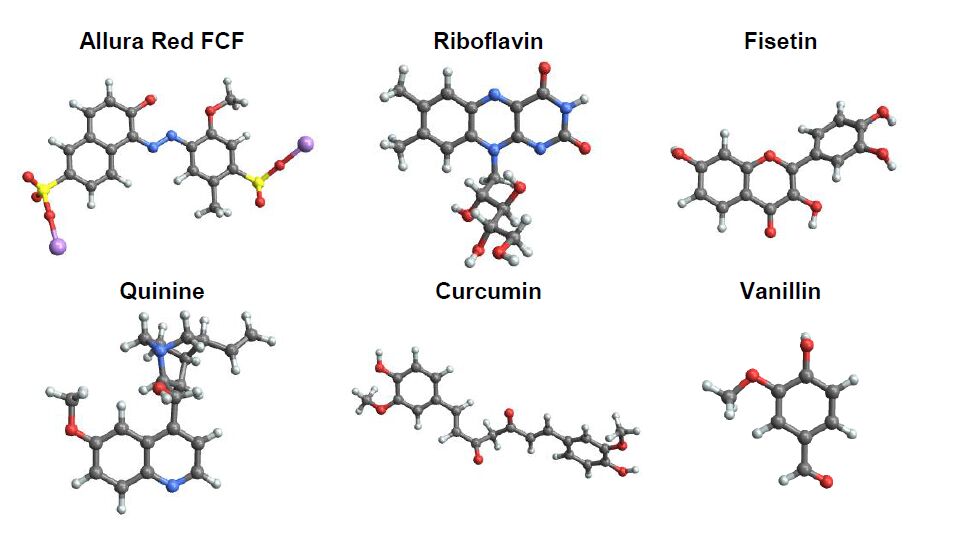
 DownLoad:
DownLoad: 